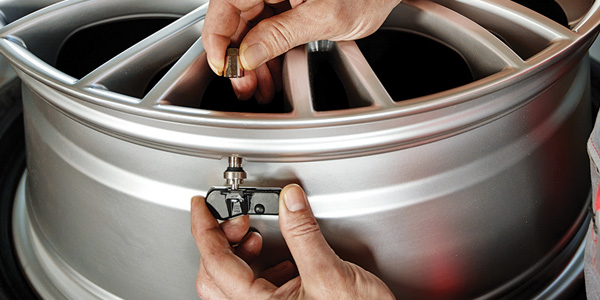TPMS and keyless entry can be difficult to understand because these systems rely on transmitting, receiving and decoding radio waves. You can see wires connecting modules and components, but seeing radio signals takes a little faith in science.
Radio waves are a type of electromagnetic radiation that have artificially organized patterns of waves so it transmits information. Still confused? Think of a TPMS sensor; it transmits a very low power signal that goes in all directions. The wave is absorbed and reflected off the vehicle and environment. The antenna on the vehicle, that could be on the windshield, in the wheel well or other locations, receives part of the wave.
TPMS sensor signals are low power and low frequency with the majority of sensors transmitting at 315 MHz or 413 MHz. Keyless entry fobs also operate at this frequency.
The other thing to remember is that similar frequencies in the same area can interfere with each other. In the 315-413 MHz range are a lot of consumer products, like home alarm systems and home automation products like smart light bulbs. In some cases, electronic devices such as phone chargers can emit unintended electromagnetic radiation.
If a TPMS sensor transmitted all the time, a sensor would not last very long. Most TPMS sensors will transmit when movement is detected through a simple accelerometer inside. If the wheel stops moving, the sensor will stop broadcasting after a programmed amount of time. But once it is triggered, the sensor transmits on a predetermined interval set by the manufacturer. A sensor will immediately send a signal if it detects a sudden loss in pressure. A sensor never receives radio signals during normal operation. The only time a sensor receives a signal is when a TPMS tool activates the sensor by emitting an electromagnetic pulse.
The TPMS will not turn the light on if a single transmission is not received; it takes multiple missed signals. The system knows that a missed or garbled transmission might be an external issue like a sensor on another vehicle transmitting at the same time or interference from the sensor being behind a brake caliper. It is like a misfire monitor, it only sets a code if the problem reaches a specific threshold.
Radio Wave Diagnostic Tips
1. Perform relearns away from other vehicles and sources of electromagnetic interference like alarms and home appliances.
2. If a vehicle can’t receive signals from a sensor during a relearn process, try rolling the vehicle forward a few feet to unblock a sensor.
3. To avoid radio frequency issues, try relearning sensor positions with a TPMS tool that can interface with the TPMS module through the OBD II port.
4. If a sensor can’t be activated with a TPMS tool, try rapidly deflating the tire by pushing in the valve stem. Hold the tool near the tire to see if the tool received the sensor’s ID.
Click here to view more solutions from Andrew Markel.














